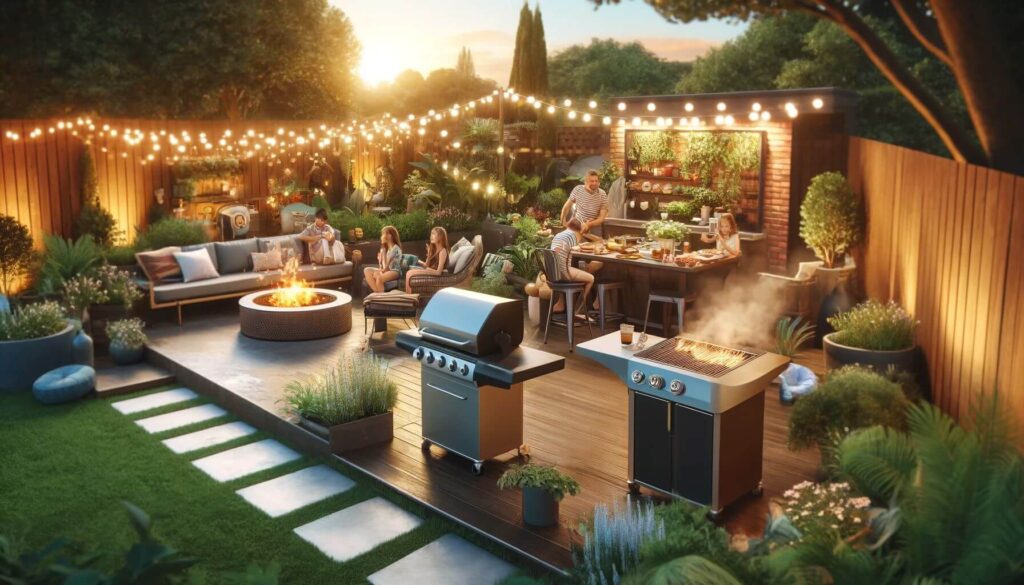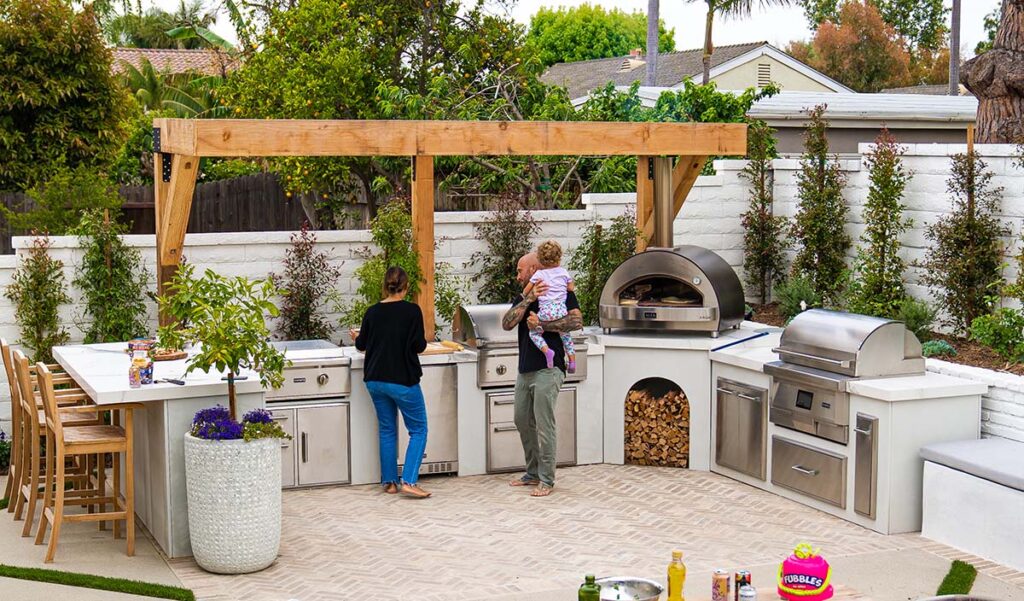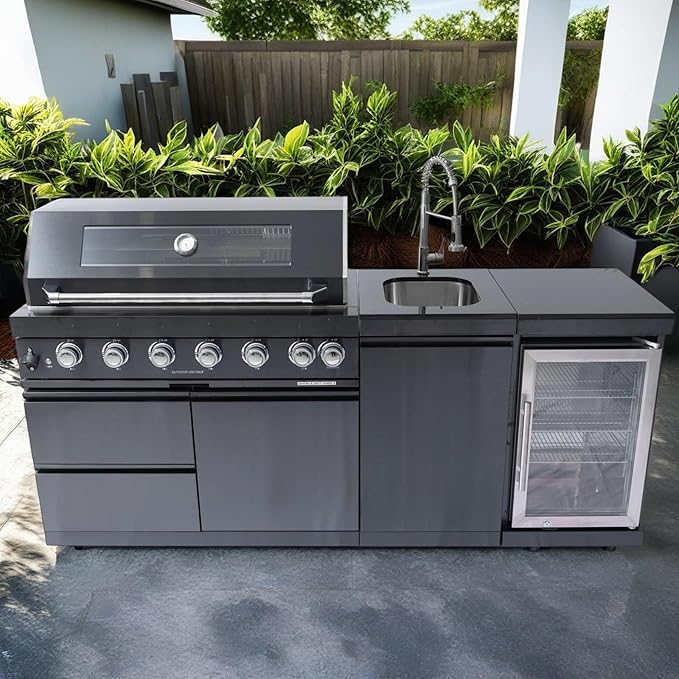When you picture a summer weekend, it often includes the smell of grilled food, family laughter, and your pets running around the backyard. A gas grill makes outdoor cooking simple and fun, but it also introduces risks that many people overlook. Flames, propane tanks, and grease can all pose hazards if not handled carefully. Keeping your outdoor space safe doesn’t just protect your family—it ensures every barbecue ends with smiles, not burns or accidents.
To keep your backyard and outdoor kitchen safe, you need a mix of good habits, smart equipment choices, and a few protective steps. That means positioning your grill properly, securing your fuel supply, creating pet-safe zones, and checking your grill before and after every use. Simple awareness and preparation can make your outdoor space a safe place for everyone, including your furry friends.
Outdoor cooking is meant to be enjoyable, not stressful. So before lighting that first burner, take a moment to make sure your setup is safe. The following sections walk you through each safety concern, from grill placement and maintenance to pet-proofing and family-friendly tips.
How far should a gas grill be placed from your house?
It might be tempting to push your grill close to the house to save space, but this is one of the biggest mistakes homeowners make. Gas grills need room to breathe. The heat and open flame can easily ignite walls, fences, or overhangs. A few feet of distance can prevent a major disaster.
Keep your gas grill at least 10 feet away from any structure, fence, or overhanging roof. This spacing ensures proper ventilation and reduces the risk of fire damage. Also, make sure there are no hanging branches or power lines nearby. Safety starts with simple spacing.
Safe Placement Checklist
| Area | Minimum Distance | Reason |
|---|---|---|
| House wall | 10 feet | Prevent wall heat damage |
| Trees or shrubs | 10 feet | Avoid catching fire |
| Patio railings | 5 feet | Maintain airflow |
| Ceiling or roof | 10 feet | Reduce smoke and heat buildup |
If you live in an apartment or small patio area, look for balcony-approved or compact gas grills that meet safety codes. Always check local regulations before grilling in shared spaces. Regularly clear leaves, debris, and furniture around your grill. Keeping the space clean makes every session safer and easier.
What surface is best for a standing gas BBQ grill placement?
Grill stability matters more than most people think. Uneven or soft ground can make a gas grill wobble, which increases the chance of tipping or fuel leaks. Hard, level surfaces help your grill stay steady during use.
The best surface for a standing gas BBQ grill is a level, non-flammable one like concrete, brick, or stone. Avoid placing it directly on grass, wood decks, or plastic mats that can melt or ignite from heat.
Safe Surface Options
| Surface Type | Safety Rating | Notes |
|---|---|---|
| Concrete patio | ★★★★★ | Heat-resistant and stable |
| Brick floor | ★★★★★ | Long-lasting and secure |
| Stone pavers | ★★★★☆ | Stylish and durable |
| Wooden deck | ★★☆☆☆ | Needs a grill mat and fireproof board |
| Grass or soil | ★☆☆☆☆ | Risk of tipping and fire |
If your grill sits on a wooden deck, use a non-slip grill mat made from heat-resistant material. It prevents grease stains and protects against stray embers. Always test the grill’s balance before cooking—wiggle it slightly to make sure all four legs are stable.

How do you design your outdoor kitchen for safe gas grill use?
Designing an outdoor kitchen isn’t only about appearance—it’s about safety and convenience. Placement, airflow, and materials all play roles in preventing fire hazards.
When designing an outdoor kitchen, keep at least 12 inches of clearance around all sides of the grill and avoid using flammable materials near it. Install ventilation panels to prevent gas buildup, especially if your grill is built-in. Stainless steel, concrete, or tile countertops are the safest choices.
Key Design Tips
| Element | Safety Advice |
|---|---|
| Grill placement | Leave enough air gap on all sides |
| Counter materials | Use heatproof surfaces like stone or steel |
| Gas line routing | Keep hoses short and protected |
| Ventilation | Add air vents for propane or natural gas |
| Lighting | Install LED lighting for safe night cooking |
Add a fire extinguisher near the grill area and teach family members where it is. If your grill has side burners, place them away from walkways to avoid contact with hot surfaces. A smart layout reduces risks without taking away from the fun of outdoor cooking.

Which children and pet-proof measures work around outdoor grilling?
Kids and pets love to be part of family barbecues. However, they don’t always understand that a hot grill is dangerous. Their curiosity can lead to serious injuries if the area isn’t secured.
The easiest way to protect children and pets is to create a no-grill zone—at least three feet around your gas grill—and use barriers or baby gates when possible. This rule keeps paws and small hands away from danger.
Safety Tips for Families
| Risk | Simple Prevention |
|---|---|
| Hot surfaces | Create a 3-foot “safety circle” |
| Open flames | Always supervise the grill area |
| Food hazards | Keep cooked and raw foods separated |
| Cords & hoses | Tuck or secure them under the frame |
| Trash bins | Use tight lids to block access |
Never leave your grill unattended, even for a minute. Pets can jump or brush against it, knocking it over or burning themselves. Consider training pets to stay off the deck during cooking. Family safety starts with consistency—if you always enforce the same rules, everyone learns faster.

How do you maintain your gas grill to prevent flare-ups?
A dirty grill is a dangerous grill. Grease buildup causes flare-ups that can quickly spiral out of control. Maintenance isn’t glamorous, but it’s essential for both flavor and safety.
Clean your gas grill after every use and inspect burners, hoses, and connectors monthly. A wire brush, mild soap, and warm water usually do the job. Avoid harsh chemicals—they can damage metal surfaces or leave harmful residues.
Cleaning Schedule
| Task | Frequency | Tools Needed |
|---|---|---|
| Brush grates | After each use | Grill brush |
| Empty grease tray | Weekly | Disposable gloves |
| Check for leaks | Monthly | Soapy water |
| Deep clean interior | Every 2–3 months | Scraper + degreaser |
Always check gas lines with a soap solution—if bubbles form, there’s a leak. Replace damaged parts right away. Keeping your grill in shape not only extends its life but also keeps your food tasting better.
How can you reduce fire risk while using a propane gas grill?
Most grill fires happen because of poor fuel management. Propane is safe when handled correctly, but leaks or misuse can quickly turn dangerous.
Store propane tanks outdoors, upright, and away from direct sunlight or heat sources. Check connections before each use and shut off the valve after cooking. Never store spare tanks inside the house or garage.
Propane Safety Quick Guide
| Safety Step | Why It Matters |
|---|---|
| Inspect hoses for cracks | Prevent leaks |
| Tighten all fittings | Ensure no gas escapes |
| Open lid before lighting | Avoid gas buildup |
| Shut off after use | Stop slow leaks |
| Store outside | Prevent heat pressure |
If you smell gas, turn off all burners immediately and move away before inspecting. Do not try to relight the grill until the smell is completely gone. Taking a few extra minutes can prevent costly damage or injury.
What accessories help keep your outdoor kitchen safe for family use?
Accessories make grilling easier—but they can also make it safer. Choosing the right tools reduces risk and adds convenience.
Invest in long-handled tools, heat-resistant gloves, grill mats, and thermometer probes. They keep you at a safe distance from flames and help prevent accidental burns.
Recommended Safety Accessories
| Item | Function |
|---|---|
| Grill mat | Protect deck or patio |
| Long tongs | Avoid hand burns |
| Heat-resistant gloves | Handle hot surfaces safely |
| Thermometer probe | Prevent undercooked meat |
| Fire extinguisher | Essential for emergencies |
Keep utensils organized and stored away after cooking. Cluttered counters increase accidents. If you often grill at night, add LED handle lights or motion-activated lamps for visibility. Small upgrades can make your entire outdoor kitchen safer and easier to enjoy.

What are common mistakes homeowners make with gas grills?
Even experienced grillers can get careless. The most common mistakes involve neglect, poor storage, and forgetting safety basics.
Common gas grill mistakes include leaving the lid closed while lighting, ignoring grease buildup, using damaged hoses, and grilling too close to structures. Avoiding these errors keeps both your equipment and your home safe.
Frequent Errors and Fixes
| Mistake | Better Practice |
|---|---|
| Lighting with lid closed | Always open lid first |
| Leaving grill unattended | Stay nearby at all times |
| Forgetting to clean grease | Empty tray regularly |
| Using old gas hoses | Replace annually |
| Grilling in enclosed spaces | Always grill outdoors |
Awareness is the easiest prevention. Treat your gas grill like any other appliance—it needs care, maintenance, and respect for safety rules.
Conclusion
A gas grill can bring joy to every meal outdoors, but safety must come first. Whether you’re grilling for family gatherings or quiet nights with your pets nearby, a little planning goes a long way. Keep your grill on a stable surface, far from structures, and inspect it regularly. Use proper tools, secure your propane tank, and maintain a clear zone for kids and pets. Safe grilling isn’t complicated—it’s consistent. Follow these steps, and your outdoor kitchen will stay a warm, welcoming, and secure space for years to come.
FAQ
- How far should a gas grill be from the house?
It is recommended to keep a gas grill at least 10 feet away from buildings, overhangs, or railings for safe clearance. (portlandtx.gov) - Can I place my gas grill on a wooden deck?
Yes—but only if you use a heat-resistant grill mat or concrete backer board beneath it and ensure proper clearance for safety. (Homes and Gardens) - What should I check before lighting my gas grill?
Check that hoses and connections are intact with no leaks, open the lid before ignition, and light only outdoors in a well‐ventilated area. (Napoleon) - How do I know when my propane tank needs replacing?
A 20 lb tank typically lasts indefinitely if maintained, but it must pass a visual inspection at 12 years and every 5 years thereafter. (resslerpropane.com) - When is it safe to cover a gas grill after use?
Wait at least 30–60 minutes for the grill to cool after cooking before placing a cover to prevent trapped heat and moisture damage. (F&J Outdoors) - Why can’t I use a gas grill indoors?
Grills designed for outdoor use can emit carbon monoxide and require open ventilation; operating them indoors or in garages is hazardous. (members.hpba.org) - What is the best surface for placing an outdoor gas grill?
A level, non-combustible surface such as concrete, brick or stone is preferred; avoid grass, soil or untreated wood below the grill. (Bbq House) - What zone should children and pets avoid around a lit grill?
Design a clear safety zone of about 3 feet (≈1 meter) around the grill where children and pets are not allowed during cooking and immediately after. (Napoleon)
